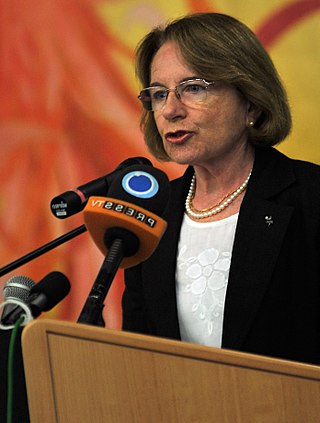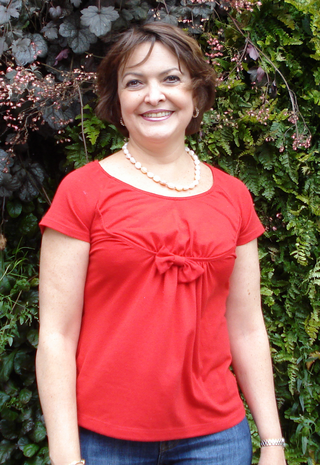
In physics, a plasmon is a quantum of plasma oscillation. Just as light consists of photons, the plasma oscillation consists of plasmons. The plasmon can be considered as a quasiparticle since it arises from the quantization of plasma oscillations, just like phonons are quantizations of mechanical vibrations. Thus, plasmons are collective oscillations of the free electron gas density. For example, at optical frequencies, plasmons can couple with a photon to create another quasiparticle called a plasmon polariton.
Naomi J. Halas is the Stanley C. Moore Professor in Electrical and Computer Engineering, and professor of biomedical engineering, chemistry and physics at Rice University. She is also the founding director of Rice University Laboratory for Nanophotonics, and the Smalley-Curl Institute. She invented the first nanoparticle with tunable plasmonic resonances, which are controlled by their shape and structure, and has won numerous awards for her pioneering work in the field of nanophotonics and plasmonics. She was also part of a team that developed the first dark pulse soliton in 1987 while working for IBM.

Miguel José Yacamán is a Mexican physicist who has made contributions to the fields of materials science, nanotechnology, and physics.

Ana María CettoKramis is a Mexican physicist and professor. She is known for her contributions to quantum mechanics, stochastic, electrodynamics, and biophysics of light, and for her work as a pacifist. From 2003 to 2010 she was Deputy Director General of the International Atomic Energy Agency (IAEA). She is also professor at the Faculty of Sciences at the National Autonomous University of Mexico (UNAM), of which she was also director. Cetto is responsible for several scientific literature programs in Latin America and for several international programs on the promotion and participation of women in science.
Ana María López Colomé is a distinguished Mexican biochemist who won the 2002 L'Oréal-UNESCO Award for Women in Science – Latin America for her studies on the human retina and the prevention of retinitis pigmentosa and several retinopathies.

Vladimir (Vlad) M. Shalaev is a Distinguished Professor of Electrical and Computer Engineering and Scientific Director for Nanophotonics at Birck Nanotechnology Center, Purdue University.

Thomas Ebbesen is a Franco-Norwegian physical chemist and professor at the University of Strasbourg in France, known for his pioneering work in nanoscience. He received the Kavli Prize in Nanoscience “for transformative contributions to the field of nano-optics that have broken long-held beliefs about the limitations of the resolution limits of optical microscopy and imaging”, together with Stefan Hell, and Sir John Pendry in 2014.
Amanda Susan Barnard is an Australian theoretical physicist working in predicting the real world behavior of nanoparticles using analytical models and supercomputer simulations and applied machine learning. Barnard is a pioneer in the thermodynamic cartography of nanomaterials, creating nanoscale phase diagrams relevant to different environmental conditions, and relating these to structure/property maps. Her current research involves developing and applying statistical methods and machine/deep learning in nanoscience and nanotechnology, and materials and molecular informatics. In 2014 she became the first person in the southern hemisphere, and the first woman, to win the Feynman Prize in Nanotechnology, which she won for her work on diamond nanoparticles.
Juan Manuel Lozano Mejía was a recognized Mexican physicist. He was one of the pioneers of nuclear physics in Mexico and an academic at Universidad Nacional Autónoma de México for over fifty years.

Pedro Miguel Etxenike Landiribar, also known as Pedro Miguel Echenique, is a theoretical solid-state physicist, Professor of Condensed Matter Physics at the University of the Basque Country (UPV/EHU), and former minister of the Basque Autonomous Community.
Manuel Peimbert Sierra is a Mexican astronomer and a faculty member at the National Autonomous University of Mexico (UNAM). He was named a foreign associate of the National Academy of Sciences in 1987.

Eugenia Kumacheva is a University Professor and Distinguished Professor of Chemistry at the University of Toronto. Her research interests span across the fields of fundamental and applied polymers science, nanotechnology, microfluidics, and interface chemistry. She was awarded the L'Oréal-UNESCO Awards for Women in Science in 2008 "for the design and development of new materials with many applications including targeted drug delivery for cancer treatments and materials for high density optical data storage". In 2011, she published a book on the Microfluidic Reactors for Polymer Particles co-authored with Piotr Garstecki. She is Canadian Research Chair in Advanced Polymer Materials. She is Fellow of the Royal Society (FRS) and a Fellow of the Royal Society of Canada (FRSC).
ISSPIC, the International Symposium on Small Particles and Inorganic Clusters, is an established biennial conference series on fundamental science of finite size effects and the possibility of controlling the properties of material at the nanometer scale, organized since 1976. The conference topics typically include atomic and molecular clusters and their assemblies, supported and free-standing nanostructures and particles, and other nanometer-scale systems.

Estela Susana Lizano Soberón is a Mexican astrophysicist and researcher. She has specialized in the theoretical study of star formation.

Tessy María López Goerne is a Mexican solid-state chemist, professor, researcher, academic, and popular science communicator. She has specialized in the fields of nanotechnology and nanomedicine, as well as being a pioneer in catalytic nanomedicine. She directs the Nanotechnology and Nanomedicine Laboratories at the Universidad Autónoma Metropolitana Xochimilco (UAM-X) plant and the National Institute of Neurology and Neurosurgery.
Tamar Seideman is the Dow Chemical Company Professor of Chemistry and Professor of Physics at Northwestern University. She specialises in coherence spectroscopies and coherent control in isolated molecules and dissipative media as well as in ultrafast nanoplasmonics, current-driven phenomena in nanoelectronics and mathematical models.
Mark Stockman was a Soviet-born American physicist. He was a professor of physics and astronomy at Georgia State University. Best known for his contributions to plasmonics, Stockman has co-theorized plasmonic lasers, also known as spasers, in 2003.
Emilie Ringe is an American chemist who is an assistant professor at the University of Cambridge. She was selected by Chemical & Engineering News as one of its "Talented Twelve" young scientists in 2021.
Paola D'Alessio Vessuri (1964–2013) was a British-born planetary scientist who worked in Mexico at the National Autonomous University of Mexico (UNAM) Center for Radioastronomy and Astrophysics. Her research concerned protoplanetary disks.
Deborah Dultzin Kessler is a Mexican astrophysicist specializing in quasars, blazars, active galactic nuclei, and supermassive black holes. She is a professor and researcher in the National Autonomous University of Mexico (UNAM) Institute of Astronomy.









